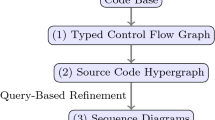Abstract
Sequence diagrams belong to three most frequently used UML diagrams and they are often an integral part of a software design. Designers utilize sequence diagrams to define and visualize designed software’s behavior. But during software development and maintenance, multiple vendor’s changes are implemented into a source code. These changes lead to inconsistencies between a software model and the source code, that are omitted due to lack of time. This paper is focused on problems with automated source code changes propagation into UML sequence diagrams. In the paper, we propose the architecture for synchronization of outdated designers’ sequence diagrams with current software behavior implemented in a source code. The proposed architecture is focused on updating and not on regenerating sequence diagrams, what helps designers to understand modified behavior and changes provided in it. We evaluated the proposed architecture via implemented extension for Eclipse Papyrus, which analyzes differences between sequence diagrams and source code model, and based on developers’ styles, it propagates differences to sequence diagrams.
Access this chapter
Tax calculation will be finalised at checkout
Purchases are for personal use only
Similar content being viewed by others
Notes
- 1.
- 2.
- 3.
- 4.
- 5.
- 6.
Replication package: https://github.com/rastocny/SOFSEM_SeqDiag_ChangeProp.
- 7.
References
Voigt, S., von Garrel, J., Müller, J., Wirth, D.: A study of documentation in agile software projects. In: Proceedings of the 10th ACM/IEEE International Symposium on Empirical Software Engineering and Measurement, p. 6. ACM, New York (2016)
Rashid, N., Khan, S.: Developing green and sustainable software using agile methods in global software development: risk factors for vendors. In: Proceedings of the 11th International Conference on Evaluation of Novel Software Approaches to Software Engineering, pp. 247–253. SCITEPRESS (2016)
Fauzi, E., Hendradjaya, B., Sunindyo, W.D.: Reverse engineering of source code to sequence diagram using abstract syntax tree. In: International Conference on Data and Software Engineering (ICoDSE), p. 6. IEEE (2016)
Srinivasan, M., Yang, J., Lee, Y.: Case studies of optimized sequence diagram for program comprehension. In: 24th International Conference on Program Comprehension (ICPC), p. 4. IEEE (2016)
Dobing, B., Parsons, J.: How UML is used. Commun. ACM - Two Decades Lang-action Perspect. 49(5), 109–113 (2006)
Reggio, G., Leotta, M., Ricca, F., Clerissi, D.: What are the used UML diagram constructs? A document and tool analysis study covering activity and use case diagrams. In: Hammoudi, S., Pires, L.F., Filipe, J., das Neves, R.C. (eds.) MODELSWARD 2014. CCIS, vol. 506, pp. 66–83. Springer, Cham (2015). https://doi.org/10.1007/978-3-319-25156-1_5
Li, X., Liu, Z., Jifeng, H.: A formal semantics of UML sequence diagram. In: Australian Software Engineering Conference 2004, pp. 1–10. IEEE (2004)
Rountev, A., Volgin, O., Reddoch. M.: Control flow analysis for reverse engineering of sequence diagrams. Technical report, Ohio State University (2004)
Emadi, S., Shams, F.: Transformation of usecase and sequence diagrams to petri nets. In: ISECS International Colloquium on Computing, Communication, Control, and Management 2009, pp. 399–403. IEEE (2009)
Pérez-Castillo, R., De Guzman, I.G.R., Piattini, M.: Knowledge discovery metamodel-ISO/IEC 19506: a standard to modernize legacy systems. Comput. Stan. Interfaces 33(6), 519–532 (2011)
Wang, Y., DeWitt, D.J., Cai., J.-Y.: X-Diff: an effective change detection algorithm for XML documents. In: 19th International Conference on Data Engineering, pp. 519–530. IEEE (2003)
Bruneliere, H., Cabot, J., Jouault, F., Madiot, F.: MoDisco: a generic and extensible framework for model driven reverse engineering. In: Proceedings of the IEEE/ACM International Conference on Automated Software Engineering, pp. 173–174. ACM, New York (2010)
Oechsle, R., Schmitt, T.: JAVAVIS: automatic program visualization with object and sequence diagrams using the Java debug interface (JDI). In: Diehl, S. (ed.) Software Visualization. LNCS, vol. 2269, pp. 176–190. Springer, Heidelberg (2002). https://doi.org/10.1007/3-540-45875-1_14
Ferenc, M., Polasek, I., Vincúr, J.: Collaborative modeling and visualisation of software systems using multidimensional UML, In: Proceedings of the Fifth IEEE Working Conference on Software Visualization VISSOFT 2017, p. 5. IEEE, Shanghai (2017)
Acknowledgement
This work was partially supported by the Scientific Grant Agency of the Slovak Republic, grant No. VG 1/0752/14, the Slovak Research and Development Agency under the contract No. APVV-15-0508, and this publication is the partial result of the Research & Development Operational Programme for the project Research of methods for acquisition, analysis and personalized conveying of information and knowledge, ITMS 26240220039, co-funded by the ERDF.
Author information
Authors and Affiliations
Corresponding author
Editor information
Editors and Affiliations
Rights and permissions
Copyright information
© 2018 Springer International Publishing AG
About this paper
Cite this paper
Rástočný, K., Mlynčár, A. (2018). Automated Change Propagation from Source Code to Sequence Diagrams. In: Tjoa, A., Bellatreche, L., Biffl, S., van Leeuwen, J., Wiedermann, J. (eds) SOFSEM 2018: Theory and Practice of Computer Science. SOFSEM 2018. Lecture Notes in Computer Science(), vol 10706. Edizioni della Normale, Cham. https://doi.org/10.1007/978-3-319-73117-9_12
Download citation
DOI: https://doi.org/10.1007/978-3-319-73117-9_12
Published:
Publisher Name: Edizioni della Normale, Cham
Print ISBN: 978-3-319-73116-2
Online ISBN: 978-3-319-73117-9
eBook Packages: Computer ScienceComputer Science (R0)




